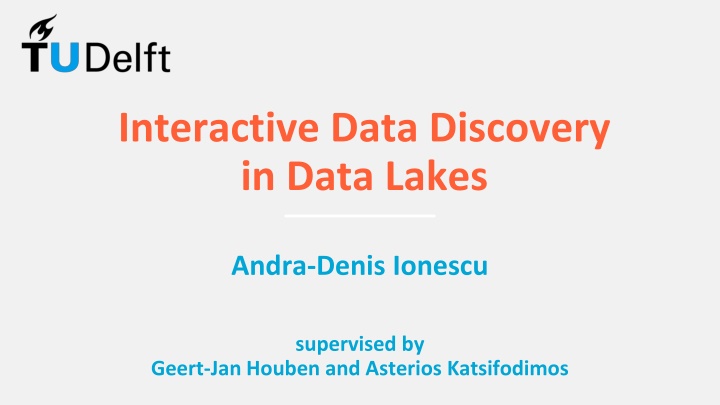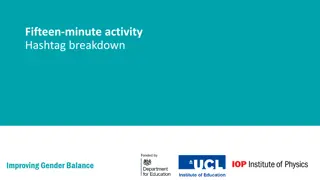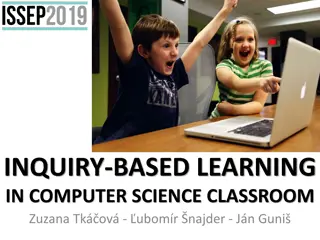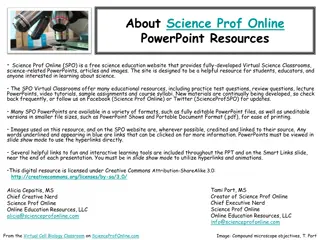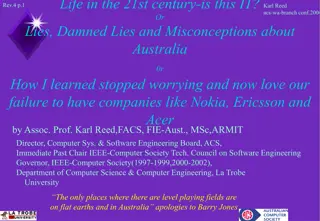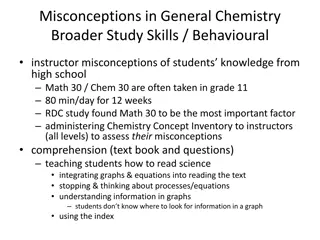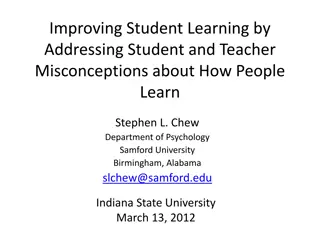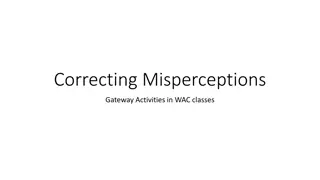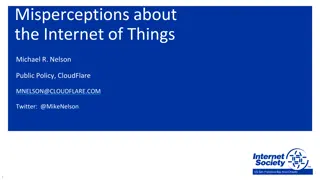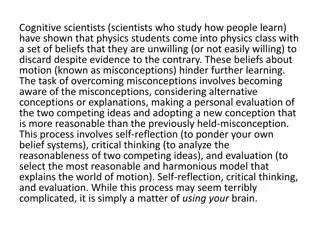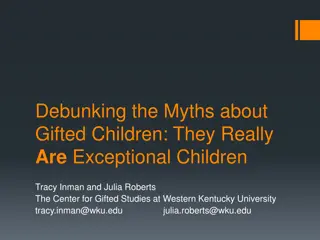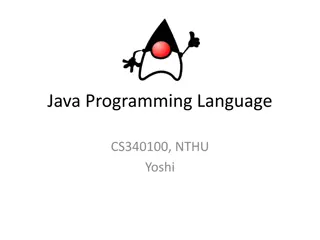Challenging Science Misconceptions
The workshop highlighted common misconceptions about science, including the belief that all chemicals are toxic, mistrust of scientific facts, lack of interdisciplinary connections in teaching, student receptiveness to scientific concepts, and suggested solutions such as emphasizing problem-solving skills and real-life applications. It emphasized the importance of understanding the complexities of science and promoting critical thinking among students.
Uploaded on Mar 17, 2025 | 1 Views
Download Presentation

Please find below an Image/Link to download the presentation.
The content on the website is provided AS IS for your information and personal use only. It may not be sold, licensed, or shared on other websites without obtaining consent from the author.If you encounter any issues during the download, it is possible that the publisher has removed the file from their server.
You are allowed to download the files provided on this website for personal or commercial use, subject to the condition that they are used lawfully. All files are the property of their respective owners.
The content on the website is provided AS IS for your information and personal use only. It may not be sold, licensed, or shared on other websites without obtaining consent from the author.
E N D
Presentation Transcript
Interactive Data Discovery in Data Lakes Andra-Denis Ionescu supervised by Geert-Jan Houben and Asterios Katsifodimos
Meet a data scientist. This user has access to a data lake and wants to create meaningful insights using only the relational datasets. The user has no knowledge about the information from the data lake, but knows what attributes the end table should have and wants as many rows as possible. 2 16-11-2020
This user has a data discovery problem. The information is known, but its place is not. The user wants to find relevant information among thousands of disparate heterogeneous datasets [1]. Current systems allow our user to: - learn a specific query language [1]; - make use of data science notebooks [2]; - use keyword search [3, 4]; - which all return top-k results that the user has to manually inspect. 3 [1] R. C. Fernandez, Z. Abedjan, F. Koko, G. Yuan, S. Madden, M. Stonebraker. 2018. Aurum: A data discovery system. In ICDE. 1001 1012. [2] Y. Zhang, Z. G Ives. 2020. Finding Related Tables in Data Lakes for Interactive Data Science. SIGMOD, 1951 1966. [3] M. J. Cafarella, A. Halevy, N. Khoussainova. 2009. Data integration for the relational web. PVLDB (2009), 1090 1101. 16-11-2020 [4] R. Pimplikar, S. Sarawagi. 2012. Answering table queries on the web using column keywords. PVLDB (2012), 908 919.
Other systems allow the user to provide a base table and find other related datasets [5, 6, 7]. - Our data scientist does not have any other base table. Interactive Data Exploration [8] - the user engages in an iterative process - query -> review data -> adjust query -> repeat - labour intensive task - usually the users do not know what they want 4 [5] A. Bogatu, A. A.A. Fernandes, N.W. Paton, N. Konstantinou. 2020. Dataset discovery in data lakes. ICDE, 709 720. [6] F. Nargesian, E. Zhu, K. Q. Pu, R. J Miller. 2018. Table union search on open data. PVLDB, 813 825. [7] E. Zhu, D. Deng, F. Nargesian, R. J Miller. 2019. Josie: Overlap set similarity search for finding joinable tables in data lakes. In SIGMOD. 847 864. 16-11-2020 [8] K. Dimitriadou, O. Papaemmanouil, Y.Diao. 2016. AIDE: an active learning-based approach for interactive data exploration. TKDE (2016), 2842 2856.
Focus of research: - dataset discovery in data lakes; - provide one result to the user instead of top-k. Returning one result requires an abundance of information about the datasets. The data lakes contain minimum amount of information - metadata. Not sufficient for this precise work => we need contextual information (context). 5 16-11-2020
Web tables - Information surrounding the tables [4, 9] - web page text and title - URL - table caption Search engines - Tailor the results by using past searches and the users interests Solution - provide context through user interactions 6 [9] M. Yakout, K. Ganjam, K. Chakrabarti, S. Chaudhuri. 2012. InfoGather: Entity augmentation and attribute discovery by holistic matching with web tables. SIGMOD, 97 108 16-11-2020
Interactive dataset discovery Provide the user with the right information in an interactive manner. Interactive Aim to improve usability by returning one result instead of top-k results. Dataset Discovery Aim to improve the user involvement by using easy and meaningful interactions that benefit both the user and the algorithms 7
Interactive dataset discovery in data lakes Use the user interactions as context Devise a strategy to create easy meaningful and sufficient interactions Return one result instead of top-k Research ranking mechanisms which combine schema matching, data profiling and users interaction profile Account for future users Short-term and long-term memory Interactive speed Aim to perform at interactive speed without decreasing the accuracy 8
Challenges User Users lose patience and interest after one second interactions Modelling interactions Transforming the user interactions into context System behaviour when there is no information about the current user Future users Interactive speed Trade-off between efficiency and effectiveness 10
Challenge #1 - User interactions Literature Vision Data discovery systems have similar user interactions: User reuses the information from the data lake without additional information (table, column information). - - - provide target table [5, 6]; provide key attributes [7, 9]; provide number of results [7, 9]. By interacting with the data, we aim to infer the user interests and build a user profile. More interactive systems use: Plan to model the user interests based on interactions and use them to return more accurate and informative results. - - - Jupyter notebooks [2]; active learning techniques [10]; specific actions to help navigate the data space [3]. 11 [10] A. Bonifati, R. Ciucanu, S. Staworko. 2014. Interactive join query inference with JIM. PVLDB (2014), 1541 1544.
Challenge #1 - User interactions Challenge Plan What is the minimum number of iterations that offers sufficient information while keeping the user engaged? Experiment with information retrieval techniques to model the user search behaviour. Experiment with human-computer interaction techniques to model the interactions. What kind of information can we extract from the interactions? 12
Challenge #2 - Modelling interactions Literature The effectiveness of data discovery algorithms => the approach used to retrieve the most relevant datasets. Top-k ranking - replaces the need of a threshold, users do not need prior knowledge [5, 6, 9]. Effectiveness is highly dependent on the quality of the data - algorithms perceive the data differently [11]. More context => more information about the datasets [3, 4]. Data lakes lack context by design [5, 12]. Vision Employ the user to generate context by interacting with the datasets and capturing the interests. Developing a ranking function that takes into account not only the similarities, but also the interactions. 13 [11] C. Koutras, G. Siachamis, A. Ionescu, K. Psarakis, J. Brons, M. Fragkoulis, C. Lofi, A. Bonifati, A. Katsifodimos. 2021. Valentine: Evaluating Matching Techniques for Dataset Discovery, to appear pages. [12] R. Hai, S. Geisler, C. Quix. 2016. Constance: An intelligent data lake system. SIGMOD 26-June-20, 2097 2100.
Challenge #2 - Modelling interactions Challenge Plan What information can we project from the interactions in order to include them in the ranking function? Context - modelled users interests. Signals - data profiles and similarities. Experiment with machine learning algorithms (linear, decision trees). What kind of aggregation function allows us to combine the context and the signals? 14
Challenge #3 - Future users Literature Vision Data discovery systems offer both access to the data and integration by modelling and developing algorithms to match the datasets [13]. A new step in the data pipeline besides access to the data and integration - mapping. Capturing the interactions, linking the data based on the users behaviour. Help the next users in the discovery process when the system lacks information about them. 15 [13] M. T. zsu, P. Valduriez. 1999. Principles of distributed database systems. Vol. 2.
Challenge #3 - Future users Challenge Plan What kind of information can we extract from past users such that it is insightful for the future users? Use the interactions and models from the previous challenges to map the information and create short-term and long-term memory. What benefits do the future users have from past users discoveries? 16
Challenge #4 - Interactive speed Literature The most basic approach for data discovery - O(n2). With millions of attributes the execution time will take too much. Reduce the search space: Vision - - - - - indexing (Elasticsearch) [2, 9] LSH [1, 5, 6] approximate query processing [14] coreset construction [15] active learning techniques [8] Maintain the accuracy, while increasing the efficiency with minimum user effort. Each method compromises either the accuracy, the efficiency, or the user effort. 17 [14] S. Chaudhuri, B. Ding, S. Kandula. 2017. Approximate query processing: No silver bullet. In SIGMOD. 511 519. [15] N. Chepurko, R. Marcus, E. Zgraggen, R. C. Fernandez, T. Kraska, D. Karger. 2020. ARDA: automatic relational data augmentation for machine learning. PVLDB (2020), 1373 1387.
Challenge #4 - Interactive speed Challenge Plan What is the minimum user effort? Leverage the power of distributed systems. What techniques allow to perform at interactive speed without decreasing the accuracy? Hybrid approach between sample space minimisation techniques and distributed algorithms. 18
Interactive Data Discovery A new approach that involves the user into the discovery process. Improve the data discovery process Using user interactions, we can learn more about their interest and provide more accurate results. 19
[1] R. C. Fernandez, Z. Abedjan, F. Koko, G. Yuan, S. Madden, M. Stonebraker. 2018. Aurum: A data discovery system. In ICDE. 1001 1012. [2] Y. Zhang, Z. G Ives. 2020. Finding Related Tables in Data Lakes for Interactive Data Science. SIGMOD, 1951 1966. [3] M. J. Cafarella, A. Halevy, N. Khoussainova. 2009. Data integration for the relational web. PVLDB (2009), 1090 1101. [4] R. Pimplikar, S. Sarawagi. 2012. Answering table queries on the web using column keywords. PVLDB (2012), 908 919. [5] A. Bogatu, A. A.A. Fernandes, N.W. Paton, N. Konstantinou. 2020. Dataset discovery in data lakes. ICDE, 709 720. [6] F. Nargesian, E. Zhu, K. Q. Pu, R. J Miller. 2018. Table union search on open data. PVLDB, 813 825. [7] E. Zhu, D. Deng, F. Nargesian, R. J Miller. 2019. Josie: Overlap set similarity search for finding joinable tables in data lakes. In SIGMOD. 847 864. [8] K. Dimitriadou, O. Papaemmanouil, Y.Diao. 2016. AIDE: an active learning-based approach for interactive data exploration. TKDE (2016), 2842 2856. [9] M. Yakout, K. Ganjam, K. Chakrabarti, S. Chaudhuri. 2012. InfoGather: Entity augmentation and attribute discovery by holistic matching with web tables. SIGMOD, 97 108 [10] A. Bonifati, R. Ciucanu, S. Staworko. 2014. Interactive join query inference with JIM. PVLDB (2014), 1541 1544. [11] C. Koutras, G. Siachamis, A. Ionescu, K. Psarakis, J. Brons, M. Fragkoulis, C. Lofi, A. Bonifati, A. Katsifodimos. 2021. Valentine: Evaluating Matching Techniques for Dataset Discovery, to appear pages. [12] R. Hai, S. Geisler, C. Quix. 2016. Constance: An intelligent data lake system. SIGMOD 26-June-20, 2097 2100. [13] M. T. zsu, P. Valduriez. 1999. Principles of distributed database systems. Vol. 2. [14] S. Chaudhuri, B. Ding, S. Kandula. 2017. Approximate query processing: No silver bullet. In SIGMOD. 511 519. [15] N. Chepurko, R. Marcus, E. Zgraggen, R. C. Fernandez, T. Kraska, D. Karger. 2020. ARDA: automatic relational data augmentation for machine learning. PVLDB (2020), 1373 1387. 20
